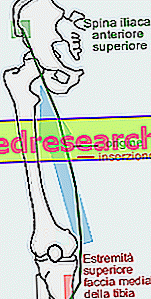
It originates from the anterior superior iliac spine and its fibers are directed obliquely downwards until they reach the tibial tuberosity.
Biarticular and ribbon-like, it is inserted on the tibia through a tendon common to the frail and semi-tendinous muscles which, due to its shape, is called a goose paw.
Crossing the long adductor muscle, he closes Scarpa's femoral triangle at the bottom which is delimited superiorly by the inguinal ligament. The nerve and the femoral vessels run in this pit. It also covers the adductor canal, a musculomembranous route located in the inferomedial part of the thigh that passes to the femoral vessels and the saphenous nerve.
With its action it flexes, extrats and abducts the thigh. He flexes and internally rotates his leg (flexed knee) collaborating with the other muscles of the goose leg. This muscle participates in a decisive way in the overlapping of the lower limbs and the sartorius name derives precisely from its ability to achieve the typical "tailor-made" sitting position.
The sartorius, the longest muscle in the human body, is innervated by the femoral nerve (L1-L3).
| ORIGIN Upper anterior iliac spine |  |
| INSERTION Upper extremity of the medial aspect of the tibia | |
| ACTION Flex the leg and thigh; externally abducts and rotates the thigh; internally rotates the leg (knee flexed) | |
| INNERVATION FEMORAL NERVE (L1-L3) |
| Upper limb | Lower limb | Trunk | Abdomen | Articles |



